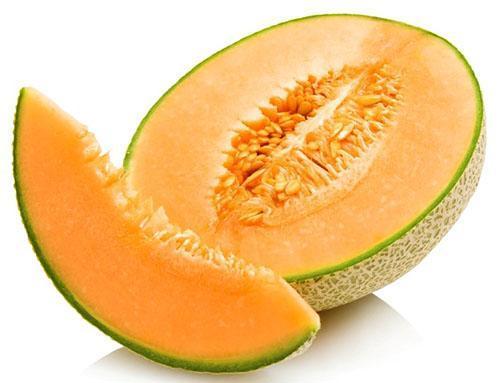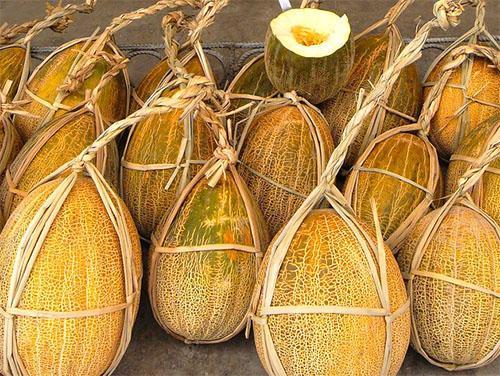How to store melon for a long time without losing its beneficial properties
 A month and a half pass and the collapse of melons and watermelons on the market disappear. How to keep a melon fresh at home, is it possible to find a place for this fragrant fruit in a city apartment? These questions are of concern to lovers of fresh garden products. The ancient experience of melon growers and new technologies allow using the melon until February. There are several proven ways to store delicate, fragrant melons in order to delight loved ones with a fresh slice in the middle of winter.
A month and a half pass and the collapse of melons and watermelons on the market disappear. How to keep a melon fresh at home, is it possible to find a place for this fragrant fruit in a city apartment? These questions are of concern to lovers of fresh garden products. The ancient experience of melon growers and new technologies allow using the melon until February. There are several proven ways to store delicate, fragrant melons in order to delight loved ones with a fresh slice in the middle of winter.
Preparing melon for storage

- select fruits of certain varieties;
- carry out proper cleaning:
- choose the right copies for storage.
Gulaba and Torpedo melons are most adapted for long-term storage, according to local Mirzachul. For storage, the fruits are chosen unripe. But the aroma from the melon should already be on. Green fruits will not gain flavor, they will deteriorate. Choose vegetables without the slightest external surface flaw. Dark spots are signs of internal decay. Too soft a nose will tell about overripe pulp that cannot be stored. There should be no cracks, dents, scratches.
The chosen fruit is torn from the vine by hands, leaving a tail of at least 3 cm. Cleaning should be carried out in cloudless weather. In the sun, melons are kept for several days, turning them on their other side under the sun for better warming. During the time spent in the garden, the fruit acquires the properties necessary for storage.
How to preserve melon for the winter
 There is a basic rule for the melon grower. If the melon needs to be stored for several months, then this is done at the place of harvest. The goods are sent to the place of sale after storage. In the southern republics, adobe premises with walls about a meter thick are arranged. It is constantly 10-13 degrees Celsius in summer, about 2-6 in winter. 0... In such a melon, the fruits of winter varieties are stored until spring.
There is a basic rule for the melon grower. If the melon needs to be stored for several months, then this is done at the place of harvest. The goods are sent to the place of sale after storage. In the southern republics, adobe premises with walls about a meter thick are arranged. It is constantly 10-13 degrees Celsius in summer, about 2-6 in winter. 0... In such a melon, the fruits of winter varieties are stored until spring.
The humidity in the room should be no more than 80%, otherwise the appearance of rot is inevitable. Airing is also necessary. But most importantly, the melon should be stored separately from other vegetables, as it absorbs alien odors, and apples accelerate the ripening of the pulp.
For preservation, each fruit is arranged in a separate woven net and hung so that the pumpkins do not touch each other and the walls. Once a month, they conduct an audit of the fruit, rejecting it with any flaws. The darkened pulp cannot be eaten, it becomes poisonous.
 How to keep a melon for the winter in the absence of a special room? Another way is to lay the fruit on a soft bedding on the shelves in the cellar. In this case, the melons should not touch each other and structures. In a small amount, the gifts of the dacha are stored in wooden boxes on a bed of sand, clean sawdust or ash... In such a container, the fruit is covered with a half-soft composition, set vertically, with the stalk down. Before the bookmark, the tail had already fallen off, there was a small speck, which is good to grind or cover with paraffin.
How to keep a melon for the winter in the absence of a special room? Another way is to lay the fruit on a soft bedding on the shelves in the cellar. In this case, the melons should not touch each other and structures. In a small amount, the gifts of the dacha are stored in wooden boxes on a bed of sand, clean sawdust or ash... In such a container, the fruit is covered with a half-soft composition, set vertically, with the stalk down. Before the bookmark, the tail had already fallen off, there was a small speck, which is good to grind or cover with paraffin.
 Such boxes can only be stored away from potatoes, otherwise the melon will stretch an earthy smell. The scent will disappear. From the boxes, the fruits are carefully removed and examined every month. In addition to the existing varieties with a long shelf life, a new variety of smooth yellow melon weighing up to 4 kg has appeared in the middle lane.Early ripening, high taste and excellent keeping quality are characteristic of the new Zheltaya Canary variety.
Such boxes can only be stored away from potatoes, otherwise the melon will stretch an earthy smell. The scent will disappear. From the boxes, the fruits are carefully removed and examined every month. In addition to the existing varieties with a long shelf life, a new variety of smooth yellow melon weighing up to 4 kg has appeared in the middle lane.Early ripening, high taste and excellent keeping quality are characteristic of the new Zheltaya Canary variety.
 In an apartment at the balcony door, the fetus can lie for a month. Late-ripening varieties Zimovka and Bykovchanka are unlikely to grow in the middle lane, but in warm regions they will lie for about 6 months. These varieties have a strong crust and a high pectin content.
In an apartment at the balcony door, the fetus can lie for a month. Late-ripening varieties Zimovka and Bykovchanka are unlikely to grow in the middle lane, but in warm regions they will lie for about 6 months. These varieties have a strong crust and a high pectin content.
There is such an indicator of keeping quality from the moment of harvesting fruits from melons:
- low keeping quality less than 15 days;
- young ones - up to 30 days;
- medium bogies - up to 60 days;
- bedridden - up to 90 days;
- very decaying ones that are stored for more than three months.
How to keep a melon in an apartment?
 Sometimes in the apartment the fruits are kept hanging in equipped cabinets with a special microclimate. More often than not, there is a problem of storage for several days. In indoor conditions with shading, a whole intact ripe melon is stored for 2 days. Moreover, it must be arranged on a soft mat in the coolest part of the apartment. If the fruit is not fully ripe, then it will lie for a week. The nose will tell you about the degree of ripening, if it is elastic, then the flesh is still firm. A strong aroma emanating from the fruit indicates its ripeness.
Sometimes in the apartment the fruits are kept hanging in equipped cabinets with a special microclimate. More often than not, there is a problem of storage for several days. In indoor conditions with shading, a whole intact ripe melon is stored for 2 days. Moreover, it must be arranged on a soft mat in the coolest part of the apartment. If the fruit is not fully ripe, then it will lie for a week. The nose will tell you about the degree of ripening, if it is elastic, then the flesh is still firm. A strong aroma emanating from the fruit indicates its ripeness.
Many housewives store ripe tomatoes in the refrigerator, and they wonder why the tomatoes changed their taste, became fibrous and watery. The same thing happens with melon, but not so noticeably.
There is a list of foods you can store in the refrigerator. Melon is not on this list. That is, the fruit, even when cut, retains its taste and aroma better in room conditions. However, sweet pulp promotes the reproduction of harmful microflora on an open surface. How long can you store a cut melon in the refrigerator is easy to decide. Store in a special container with a sealed lid for no more than 2 days. If the fruit is intact, then it will lie on the bottom shelf in the vegetable section for more than a week.
 It is necessary to remember about hygiene. All food in the refrigerator must be kept in an airtight container. This will preserve the individual flavor of each product. For this, the industry produces containers of various sizes with tight lids. It is very convenient to store various semi-finished products in such containers.
It is necessary to remember about hygiene. All food in the refrigerator must be kept in an airtight container. This will preserve the individual flavor of each product. For this, the industry produces containers of various sizes with tight lids. It is very convenient to store various semi-finished products in such containers.
 Before placing in the refrigerator, the melon is thoroughly washed with a brush and a simple laundry soap. After that, wrap the dried product in a canvas cloth and put it in a special container. Can melon be kept in the refrigerator for a long time? The shelf life of a melon in the refrigerator cannot be lengthened, since ethylene is formed in the ripe pulp at low temperatures, the fruit becomes unsuitable for food.
Before placing in the refrigerator, the melon is thoroughly washed with a brush and a simple laundry soap. After that, wrap the dried product in a canvas cloth and put it in a special container. Can melon be kept in the refrigerator for a long time? The shelf life of a melon in the refrigerator cannot be lengthened, since ethylene is formed in the ripe pulp at low temperatures, the fruit becomes unsuitable for food.
 Long-term storage of frozen pulp in the form of slices or balls will add variety to the winter menu. At the same time, most of the useful elements are preserved.
Long-term storage of frozen pulp in the form of slices or balls will add variety to the winter menu. At the same time, most of the useful elements are preserved.